The following information is summarized from the Northern Colorado Plateau Network monitoring plan, published in 2004. Some details may have changed.
Park History and Purpose
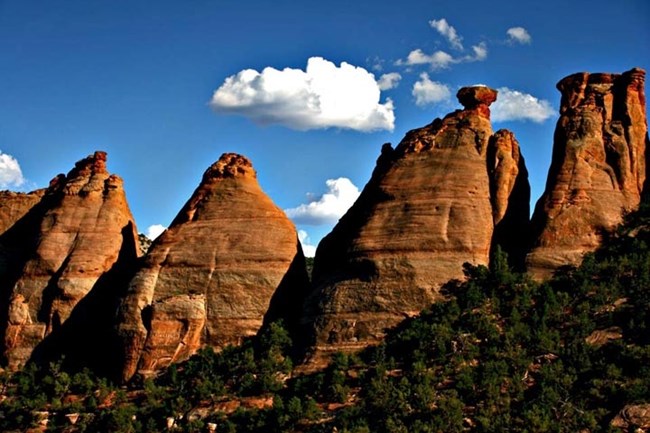
NPS
Colorado National Monument was established by William Howard Taft’s Presidential Proclamation (Number 1126) on May 24, 1911. The Proclamation stated that the monument’s purpose was to reserve in the public interest “the extraordinary examples of erosion (which) are of great scientific interest . . . together with as much public land as may be necessary for the proper protection thereof.” In 1916, the National Park Service was created and assumed administration of the monument.
Subsequent proclamations have broadened the original mandate for managing Colorado National Monument. The Hoover Proclamation of 1933 added “certain adjoining lands for the purpose of including . . . features of historic and scientific interest and for the protection of the rim road and for administration purposes . . . .” The Eisenhower Proclamation of 1959 reaffirmed the above proclamation.
Location
Colorado National Monument is located in west-central Colorado, just west of Grand Junction. The monument is about 16 kilometers (10 miles) long and 5–10 kilometers (3–6 miles) wide. It is situated on the northeastern edge of the Colorado Plateau, at the transition to the Rocky Mountain province.
Elevation
Elevation ranges from 1,408 meters (4,620 feet) at the foot of the cliffs to 2,166 meters (7,107 feet) on the mesa above the canyons.
Size
8,310 hectares (20,534 acres)
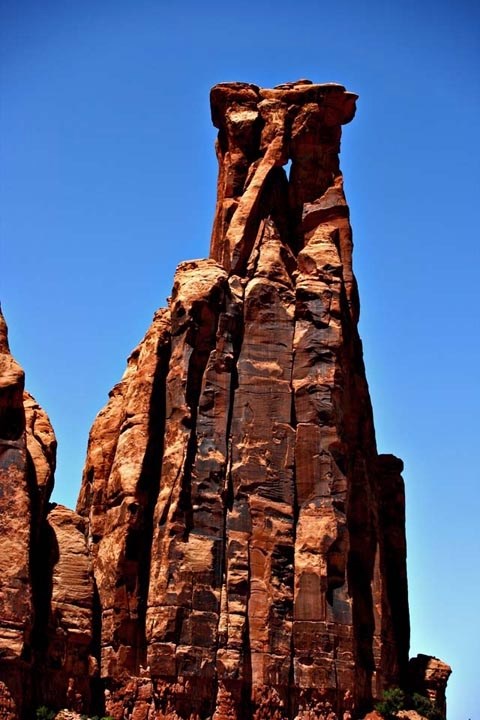
NPS
General Description
Colorado National Monument lies on the northeastern edge of the Uncompahgre Plateau, where it abruptly terminates and adjoins the Grand Valley. The landscape contains outstanding geologic features, exposed and sculpted by erosion. Geologic history, ranging from the ancient crystalline rocks of the Precambrian age to the soft, mixed shales and sandstones of the Jurassic-age Morrison Formation, is recorded in the exposed cliffs. The massive Wingate Formation, lying midway in the stratigraphic sequence, forms the steep canyon walls and dominates the scenery.A semi-desert upland climate prevails, with an average of less than 280 millimeters (11 inches) of annual precipitation. Temperatures vary from summer highs in the high 90s Fahrenheit to winter lows sometimes dipping into the sub-zero range. Snowfall averages 96 centimeters (38 inches), with the heaviest accumulations usually in January. There are no perennial streams in the monument. Ephemeral surface flows, seeps, and potholes supply water for wildlife throughout most of the year.
Plants and Animals
Visitors may encounter a wide range of native and nonnative plant and animal species throughout the site.
Flora
Dominant vegetation communities are the pinyon-juniper woodland, grassland, and upland shrub communities typical of the Colorado Plateau physiographic province. Pinyon-juniper woodland densely covers the higher elevations above the cliffs, and sparsely covers canyon sides. Thick stands of Gambel oak are found within the upper reaches of some drainages. Open areas dominated by big sagebrush (Artemisia tridentata), rabbitbrush (Chrysothamnus spp.), and greasewood (Sarcobatus vermiculatus) are scattered in canyon bottoms. Riparian communities in canyon bottoms include coyote willow/horsetail (Salix exigua/Hippochaete hyemalis) and tamarisk/Russian olive (Tamarix chinensis/Elaeagnus angustifolia). Other species in riparian zones include Rocky Mountain willow (Salix monticola), western river birch (Betula occidentalis), and several orchids.
The monument provides excellent examples of plant communities in near pristine condition. Researchers documented one relict site on an isolated mesa with a community of pinyon pine/mountain mahogany (Pinus edulis/Cercocarpus montanus) in 1990. They also found relict species, including Douglas-fir (Pseudotsuga menziesii) and manzanita (Arctostaphylos patula), elsewhere in the monument.
Grazing by an introduced herd of bison, eliminated in 1983, altered vegetation cover and composition in the monument area below the cliffs. Exotic invasive species were introduced in canyon riparian habitats, along roadsides, and in other disturbed sites. The vascular flora record includes more than 76 families, 276 genera, and 484 species, based on specimens in the monument’s herbarium and on a checklist developed in 1985. An identification guide for cacti describes eight species. The Colorado Natural Heritage Program lists 14 sensitive plant species for the monument. Only 55 lichen species have been identified.
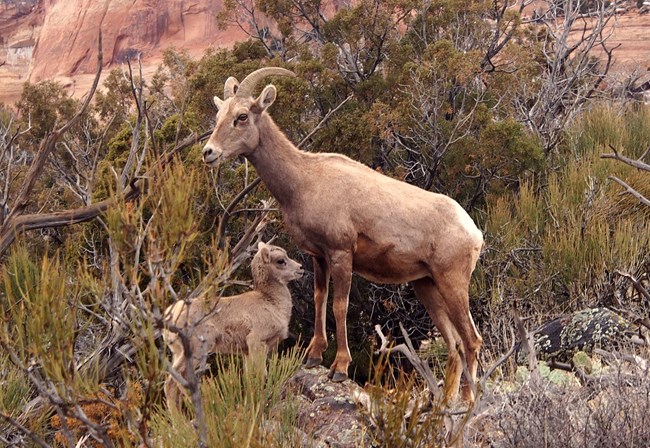
NPS
Fauna
The checklist of mammals includes 53 species. Desert bighorn sheep were reintroduced in 1979. Eight bat species are known to be present; there is suitable habitat for five additional species. A herd of bison was introduced and maintained from 1925 to 1983.
The checklist for birds includes 164 species. Monitoring projects are ongoing for peregrine falcons and gray vireos.
The checklist of amphibians and reptiles includes 23 species: one salamander, two toads, two frogs, seven lizards, and eight snakes. Rare species of note are the midget-faded rattlesnake (Crotalus viridis concolor) and Utah blackhead snake (Tantilla planiceps); the clouded tiger salamander (Ambystoma tigrinum), Great Basin spadefoot (Spea intermontana), and canyon treefrog (Hyla arenicolor). Arthropods have been recorded in a 23-page checklist produced in 1994. A list of butterflies and moths includes more than 200 species.
Aquatic Features
Springs, seeps, and tinajas provide habitat for amphibians and riparian plants. There are no fish within the monument.
Unique Features and Species of Special Concern
Vegetation Communities
Riparian communities in canyon bottoms include coyote willow/horsetail (Salix exigua / Hippochaete hyemalis), which is also habitat for the canyon bog orchid (Platanthera sparsiflora var. ensifolia). Two other plant associations, Utah juniper/Salina wildrye (Juniperus osteosperma / Elymus salinus) and pinyon pine/mountain mahogany/Salina wildrye (Pinus edulis / Cercocarpus montanus / Elymus salinus), are identified in the 1984 “Plant Associations of Special Concern in Colorado.”
Plants
Of the 14 sensitive plant species listed for the monument by the Colorado Natural Heritage Program, at least two need status surveys and monitoring. The Canyonlands lomatium (Lomatium latilobum) is described as “one of the rarest plants in Colorado.” It grows on climbable shelves of the Wingate Sandstone cliffs in canyons that are popular with hikers. Canyon bog orchid (Platanthera sparsiflora var. ensifolia) depends on a reliable supply of moisture year-round, which is found only in a few canyon seeps. In addition, Uinta Basin hookless cactus (Sclerocactus glaucus), a listed threatened species, has been reported (unverified) at one location in the monument close to a suburban development.
Animals
Colorado National Monument provides a critical and protected haven for Coloradoan bats. Of the 12 bat species that are known to be present, the Townsend’s big-eared bat (Corynorhinus townsendii pallescens) is listed as a former species of concern; it is the major impetus and focus of the Colorado Division of Wildlife’s Bat/Abandoned Mine Conservation Project. The fringed myotis (Myotis thysanodes) and the big free-tailed bat (Nyctinomops macrotis) are also considered rare in Colorado. There is potential habitat for the endangered spotted bat (Euderma maculatum).
There have been inventories, mapping, and ongoing monitoring of American peregrine falcon (Falco peregrinus anatum), gray vireo (Vireo vicinior), and plumbeous vireo (Vireo plumbeus). The National Audubon Society has designated the monument as an Important Bird Area.
The desert bighorn sheep population is estimated at 75 individuals. The Colorado Division of Wildlife continues to monitor the herd.
Rare reptile and amphibian species of note are the midget-faded rattlesnake (Crotalus viridis concolor) and Utah blackhead snake (Tantilla planiceps); the clouded tiger salamander (Ambystoma tigrinum), Great Basin spadefoot (Spea intermontana), and canyon treefrog (Hyla arenicolor). University of Windsor, Ontario, researchers conducted iguanid lizard surveys and behavioral studies from 1988 to 1994.
Outside researchers discovered five new moth species in 1998. Independent surveys for Lepidoptera should be supplemented with inventories, monitoring, and documentation by NPS to enable management planning for this resource.
Resource Management Concerns
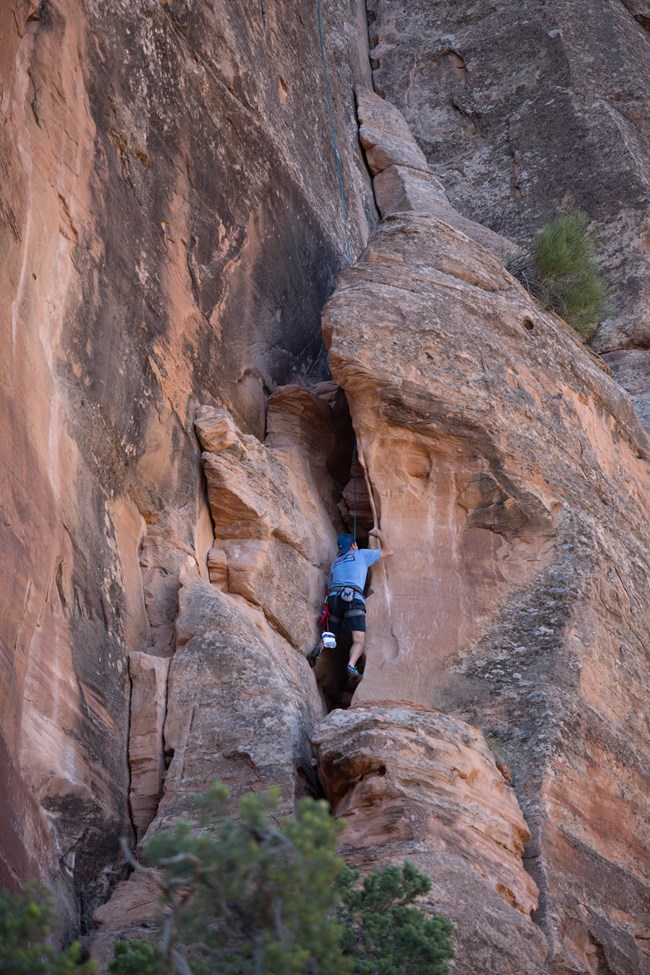
NPS / Victoria Stauffenberg
Recreational Use
The number of hikers entering from public trailheads near Grand Junction and from residential developments at canyon mouths is increasing rapidly. A baseline documentation and condition assessment of the trails system is underway in preparation for development of a trails management plan. Baseline inventories of riparian habitats and sensitive amphibian and plant species in these canyons need to be completed and coordinated with the trails planning.
Hiking in canyons and off-road vehicle intrusions from Bureau of Land Management (BLM) land in the backcountry threaten to accelerate erosion of geologic resources. Monitoring of vegetation cover and mapping of social trails could provide measurements of the impacts.
Land Use Impacts
Growth in the Grand Valley has brought housing and commercial buildings up to the boundary. Increased public use of BLM lands along the western boundary also impacts resources. Inventories and monitoring resources are needed to provide information for a sustainable resource management plan.
Sensitive Plant Species
The Canyonlands lomatium (Lomatium latilobum) grows on climbable shelves of the Wingate sandstone cliffs in popular hiking areas where trails are unmarked. The canyon bog orchid (Platanthera sparsiflora var. ensifolia) grows in wet areas of canyon bottoms that attract hikers. Plant populations need to inventoried, mapped, and protected by marking trails to route hikers around sensitive habitat.
Vegetation Management
Utah juniper and pinyon pine tree mortality rates have increased over the past several years. They have a root fungus, probably augmented by drought stress. A determination should be made as to mortality causes, whether natural or anthropogenic, and the effect on other NPS areas as well. Mitigation measures and monitoring of causal factors should be considered.
Fire potential is a concern because of adjacent residential areas. Increasing numbers of dead trees and increasing cheatgrass cover are two factors that contribute to fuel load. Collection of natural fire regime data and monitoring of vegetation and ground cover is needed to provide information for fire management.Permanent vegetation monitoring plots were established in several locations in 1982 and read in 1985 to measure effects of air pollution from a refinery in Fruita. The refinery is not in operation now. Recent samples of lichens and cryptobiotic crusts show evidence of damage attributable to air pollutants (NPS 1999a). Lichens on the cliffs that face the adjacent city of Grand Junction could provide a monitoring tool for measuring air pollution effects on monument vegetation.
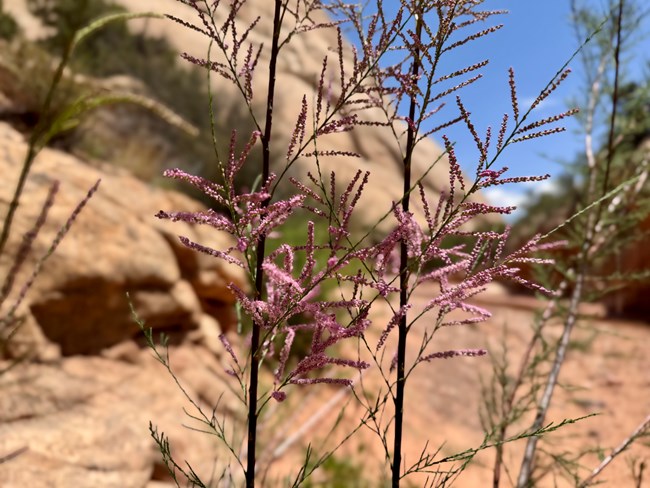
NPS/Amy Washuta
Invasive Exotic Plant Species
Tamarisk (Tamarix ramosissima) has received the most attention at the monument, starting in about 1995. The Lake Mead tamarisk terminators treated all except about 15 kilometers (9 miles) of canyon habitat in 1997. Monument staff and volunteers have continued treatments and follow-ups each year. Pre-treatment maps are in the monument GIS. Additional follow-up treatments and documentation are needed.
Russian olive (Eleagnus angustifolia) was removed and needs follow-up documentation. Other species of greatest concern are Russian knapweed (Centaurea repens) and cheatgrass (Bromus tectorum). The knapweed populations, mapped and sprayed for several years, continue to need follow-up spraying and documentation. Cheatgrass exists throughout the monument in areas impacted by past bison grazing as well as other disturbances; on some roadsides it is found to the exclusion of other species.
Yellow sweetclover (Melilotus officinalis) has been sprayed along some roadsides. This species and the Russian thistle (Salsola australis) have not had a treatment plan implemented.
Animals
There are no data on mountain lion population size and movement. In anticipation of potential conflicts between increasing visitation, basic data needs to be collected and maintained.
Amphibian reproduction is threatened by recreational use of ephemeral pools in the lower canyons where hikers play in water. Amphibian surveys and monitoring data are needed for trail planning and recreation management.
The desert bighorn sheep herd is being monitored. There is continued mortality among adults and lambs. Recommendations are for one or two additional translocations.
The Colorado Division of Wildlife and Colorado National Monument have collected many years of site data for peregrine falcons (Falco peregrinus). These data need to be consolidated.
Prairie dogs towns along the boundary with residential subdivisions should be monitored periodically.
Last updated: June 27, 2025
